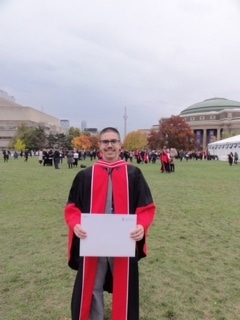
Karl Lamothe, son of Hille (Milles) and David Lamothe grandson of Helga Milles and the late Linold Milles recently achieved his PhD in Ecology and Evolutionary Biology at the University of Toronto.
For his studies Karl Lamothe developed a way to measure the resilience of freshwater ecosystems to human-caused disturbances. Although freshwater ecosystems provide us with a suite of benefits such as clean water to drink, freshwater fish for food and recrewith ational angling, as well as many others, they are also some of the most threatened systems on our planet. Shoreline development by society has led to nutrient problems in our waters, species invasions, and climate change is altering the way in which freshwater ecosystems function. The study developed a way to measure the resilience of freshwater ecosystems to these disturbances. Karl used tools from statistics and longterm environmental data to demonstrate a quantitative framework for measuring resilience and found that lake systems in Ontario have changed over the last 30 years, both in terms of water chemistry as well as the organisms that live there, indicating a lack of resistance to change.
Karl Lamothe was offered a 3-year position with the federal Department of Fisheries and Oceans Canada at the Great Lakes Laboratory for Fisheries and Aquatic Sciences. As a result he is moving from Toronto to Burlington, Ontario. It will be a smooth transition from his University degree into a new job.
PS. Linold Milles, Karl Lamothe’s grandfather was the president of the New York Estonian Educational Society during 1971-1982. Among other endeavors, he was also one of the founders and leaders of the NY Estonian Boy-Scout troup “Viiking”. His leadership years in the New York Estonian Education Society belonged to the times when NYEstonian House served a large number of active members and where the Estonian academic and other organisations met for meetings and social gatherings. There were close to a 100 members in both male and women choruses, there were folkdance and gymnastic troups, amateur theater and of course the NYEstonian Supplementary School with its numerous children. During these ‘refugee years’, before Estonia gained its independence again, numerous cultural endeavors were held at the NYEstonian House every year, including all kinds of lectures regarding history, literature, sciences, politics, art, etc. It is not overly complimentary to compare the NY Estonian House during those ‘refugee years’ to an “Adult Educational University”, where many a younger generation Estonian, including his own daughters acquired a deeper knowledge about Estonia and Estonians.
Täienduseks. Karl Lamothe vanaisa Linold Milles oli NYE Haridusseltsi esimees aastatel 1971 – 1982. Samuti oli ta üks skautlipkonna “Viiking” asutajaid ja juhataja kaua aastaid ning USA Skautmaleva juht. Tema ametiaeg NYEH kuulus veel ajajärku, kui NYEesti Maja oli täis hoogsat tegevust, kus toimusid organisatsioonide kokkutulekud-koosolekud, harjutasid laulukoorid, rahvatantsurühm ja võimlejad ning muidugi suurearvuline New Yorgi Eesti Täienduskooli pere. Peale selle korraldati nagu pea kõigil pagulasaastail palju kultuurilisi ettevõtmisi ja loenguid nii eesti ajaloo, kirjanduse, poliitika, teaduse, kunsti jt. aladel. NYE Maja tegevust pagulasaastatel võiks võrrelda “rahvaülikooliga”, kus paljud noorema põlve eestlased omandasid laiemaid teadmisi nii eesti keele kui kultuuri kohta.
Põgenike lipukirjaks oli noortele haridus, sest teadmised on vara, mida koi ega rooste ei riku ja mida keegi ei saa sult võtta. Seda oldi hästi kogetud läbi põgenemiste ja pagulasaastate. Nagu reformatsiooni tagajärjel, kui talupoeg sai võimaluse hariduse saamiseks, nii ka Eestis kõrghariduse saanud pagulased, kes oma uuel kodumaal pidid ülalpidamist teenima ning uut elu alustama lihttöölistena ning omi sponsoreid teenima vähemalt aasta, tegid esimesel võimalusel uuesti oma ametikohased eksamid. See võimaldas jälle omal alal tööle asuda (nagu arstid) või siis kasutati omi teadmisi uute firmade loomiseks. Samuti püüti anda õppevõimalusi oma järeltulijatele, kes tänu headele õpitulemustele said sageli stipendiume. See polnud kerge, aga eesti talupoja visadusega ületati raskused, vahel ka abi ja nõu saades varem emigreerunud kaasmaalastelt.
Kõige selle kõrval oli tähtis alustada eesti organisatsioonidega keele ja kultuuri säilitamiseks. Poliitiline tegevus piirdus alul Eesti ja Eesti saatuse tutvustamisega. Kuid peale viit aastat oli võimalik saada ka kodanikuõigused ning siis alustati ka poliitilise organisatsioonide loomisega või ühineti Ameerika organisatsioonidega, et mõjutada maailmavaateid ja kindlustada mittetunnustust Eesti okupeerimisele. Tõhusalt aitas siin kaasa ka Eesti konsulaadi olemasolu.
Aime Andra













